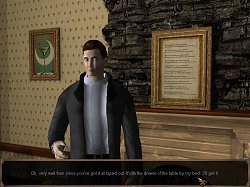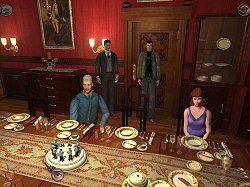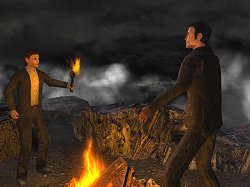|
Agatha Christie: And Then There Were None
 Ten people, strangers to each other, are lured to Shipwreck Island off the south coast of England by their mysterious host, U.N. Owen. After their first dinner together a recorded message informs them that each stands accused, by their action or inaction, of causing the death of an innocent person or persons. With no way back to the mainland retribution will be meted out to each one in turn unless they can first unmask their unknown host. The quaint, if childish, nursery rhyme that adorns the mantelpiece will soon take on a sinister aspect.
Of course it will all sound familiar if you've read Agatha Christie's novel, And Then There Were None, (also known as Ten Little Indians). However, this game is not simply a retelling of Christie's well known murder mystery as writer, Lee Sheldon, has deviously woven in some surprises by developing the plot using ideas suggested by the background to the location, and the era of the story.
There is also the introduction of an eleventh character, Patrick Narracott, the boatman, who ferries the guests to the island and becomes stranded along with them. Who knows what will happen! Perhaps the uninvited Narracott can thwart the plans of the unknown host ... perhaps not!
Agatha Christie: And Then There Were None has a marvellous introduction showing the guests travelling to the Sticklehaven wharf where they will board a boat to take them to the island. Each guest gets a snippet of the action when their temperaments and, perhaps even their foibles, are exhibited ... just enough to get you thinking. The game gets underway once Narracott learns that he too has no way to leave the island. Ten people, strangers to each other, are lured to Shipwreck Island off the south coast of England by their mysterious host, U.N. Owen. After their first dinner together a recorded message informs them that each stands accused, by their action or inaction, of causing the death of an innocent person or persons. With no way back to the mainland retribution will be meted out to each one in turn unless they can first unmask their unknown host. The quaint, if childish, nursery rhyme that adorns the mantelpiece will soon take on a sinister aspect.
Of course it will all sound familiar if you've read Agatha Christie's novel, And Then There Were None, (also known as Ten Little Indians). However, this game is not simply a retelling of Christie's well known murder mystery as writer, Lee Sheldon, has deviously woven in some surprises by developing the plot using ideas suggested by the background to the location, and the era of the story.
There is also the introduction of an eleventh character, Patrick Narracott, the boatman, who ferries the guests to the island and becomes stranded along with them. Who knows what will happen! Perhaps the uninvited Narracott can thwart the plans of the unknown host ... perhaps not!
Agatha Christie: And Then There Were None has a marvellous introduction showing the guests travelling to the Sticklehaven wharf where they will board a boat to take them to the island. Each guest gets a snippet of the action when their temperaments and, perhaps even their foibles, are exhibited ... just enough to get you thinking. The game gets underway once Narracott learns that he too has no way to leave the island.
 It's a third person perspective adventure game where you play as Narracott. The murders, once they start, will continue until none of the guests are left unless you can stop the killer. But, be warned, if you get too close you may become the next victim. There are several possible endings so be sure to experiment towards the end so you don't miss anything. I managed to save two characters the first time around.
In this classic 'whodunit' you will search the house and the island and interrogate the guests looking for means, motive and opportunity. Despite the seemingly restrictive setting there are lots of locations to explore and plenty of items to find, or take note of, or use. The house is handsomely decorated with the dining room table intricately laid out, a library lined with books, a games room, screening room, and many guest bedrooms to rummage through for clues. Outside there are more locations on the island including secluded beaches and various tumbled down places. It's all mouse-controlled so you move Narracott around by pointing and left clicking. Double clicking will get him to run. It's a third person perspective adventure game where you play as Narracott. The murders, once they start, will continue until none of the guests are left unless you can stop the killer. But, be warned, if you get too close you may become the next victim. There are several possible endings so be sure to experiment towards the end so you don't miss anything. I managed to save two characters the first time around.
In this classic 'whodunit' you will search the house and the island and interrogate the guests looking for means, motive and opportunity. Despite the seemingly restrictive setting there are lots of locations to explore and plenty of items to find, or take note of, or use. The house is handsomely decorated with the dining room table intricately laid out, a library lined with books, a games room, screening room, and many guest bedrooms to rummage through for clues. Outside there are more locations on the island including secluded beaches and various tumbled down places. It's all mouse-controlled so you move Narracott around by pointing and left clicking. Double clicking will get him to run.
The cursor is a 'smart' one. It changes to indicate where, and what, actions may be carried out such as talk (a mouth), take (a hand), look (an eye), walk (feet) or use (gears). On occasion you can also listen at a door, or peek through a keyhole, which are useful sleuthing activities as you never know what you may overhear or see.
Shipwreck Island is a great place to explore with various incidental or background items such as chairs and radiators and other paraphernalia available for inspection when the 'eye' cursor appears. These and other items may elicit a response from Narracott when you 'look' at them in the game world. This ability to look at extraneous objects always brings a game to life for me although I was surprised that you couldn't identify some collectable objects until they were safely tucked away in your inventory. Of course, obvious things such as books and garden implements need no prior identification but there were some smaller and less distinct objects that remained a mystery until identified in the inventory. A small thing, maybe, but as in real life it's always good to know what you are picking up before it's in your hand.
On a similar note there are a couple of environmental objects that you need to interact with that are not identified in any way until you use the correct item on them. A little inconsistent as it is clearly signalled that other objects are of particular interest. Because of this one important interaction with an object escaped me for a while as I thought it was just part of the scenery. I mention this as a warning so you don't make the same mistake.
 Now having got my couple of complaints out of the way, I should add that finding what you want in And Then There Were None is generally quite intuitive with only one item that demands extra careful searching. You can easily identify everything you pick up in the excellent inventory which is more compact, but rather like the inventory used in such games as Voyage or Return to Mysterious Island. It consists of multiple screens of 12 slots, and expands to accommodate all the items as you pick them up. Seemingly it could go on forever. This makes it very easy to organise your collection and group similar items together, such as books in one screen, scraps of paper in another and fingerprints in the next, etc.
In your inventory you can also examine some items in more detail or combine and even separate them if necessary by using the bottom row of slots. This row is static, it doesn't change when moving from screen to screen, so it doubles as a temporary holding area from which you can easily swap objects around. The inventory is so well designed it's hard to fault, though I did wish that newly acquired items slipped into the manipulating or organizing row ready to be sorted appropriately, rather than disappearing into the, sometimes, elusive available slots.
In addition to his inventory Narracott also has a journal where he keeps notes of the things he has learned about the guests, or the island, and important documents are stored here as well. It's a good reference point for keeping track of things although taking supplementary notes does come in handy. Both the journal and the inventory icons will flash when new information has been added. Now having got my couple of complaints out of the way, I should add that finding what you want in And Then There Were None is generally quite intuitive with only one item that demands extra careful searching. You can easily identify everything you pick up in the excellent inventory which is more compact, but rather like the inventory used in such games as Voyage or Return to Mysterious Island. It consists of multiple screens of 12 slots, and expands to accommodate all the items as you pick them up. Seemingly it could go on forever. This makes it very easy to organise your collection and group similar items together, such as books in one screen, scraps of paper in another and fingerprints in the next, etc.
In your inventory you can also examine some items in more detail or combine and even separate them if necessary by using the bottom row of slots. This row is static, it doesn't change when moving from screen to screen, so it doubles as a temporary holding area from which you can easily swap objects around. The inventory is so well designed it's hard to fault, though I did wish that newly acquired items slipped into the manipulating or organizing row ready to be sorted appropriately, rather than disappearing into the, sometimes, elusive available slots.
In addition to his inventory Narracott also has a journal where he keeps notes of the things he has learned about the guests, or the island, and important documents are stored here as well. It's a good reference point for keeping track of things although taking supplementary notes does come in handy. Both the journal and the inventory icons will flash when new information has been added.
 The puzzles, or obstacles to progress, range from fairly straightforward to intriguingly devious but all remain firmly within the context of the story. And your mysterious adversary sometimes even leaves cryptic clues around to point you in the right direction. There are no mazes, timed sequences, tone matching or slider puzzles to frustrate those adventurers who are averse to such things, just good solid adventuring. There are many things to investigate and lots of things to do ... not all of them crucial to the plot or advancing the story, but still fun, and they help to create a feeling of openness in the game world.
As with any self-respecting investigation you do need to visit locations again and again in order to meet up with and talk to characters to elicit more information, and perhaps to trigger the story along. The characters certainly won't hang around in one spot just waiting for you to find to them as they have their own agendas and for most of them this involves staying alive. However, it's never too difficult to find something happening and Narracott will often steer you in the right direction by either refusing to visit certain areas or suggesting the place to go. The puzzles, or obstacles to progress, range from fairly straightforward to intriguingly devious but all remain firmly within the context of the story. And your mysterious adversary sometimes even leaves cryptic clues around to point you in the right direction. There are no mazes, timed sequences, tone matching or slider puzzles to frustrate those adventurers who are averse to such things, just good solid adventuring. There are many things to investigate and lots of things to do ... not all of them crucial to the plot or advancing the story, but still fun, and they help to create a feeling of openness in the game world.
As with any self-respecting investigation you do need to visit locations again and again in order to meet up with and talk to characters to elicit more information, and perhaps to trigger the story along. The characters certainly won't hang around in one spot just waiting for you to find to them as they have their own agendas and for most of them this involves staying alive. However, it's never too difficult to find something happening and Narracott will often steer you in the right direction by either refusing to visit certain areas or suggesting the place to go.
And Then There Were None is a classy production. The background graphics are excellent with the plush interior locations capturing the pre World War II ambiance, and the island is suitably depicted in its rugged, wind-swept isolation. The pounding waves on the shore and rain and lightning effects complete the brooding atmosphere. The music, too, nicely captures the mood of the period and slips unobtrusively into the background for most of the game. The piano piece during the introduction really sets the tone.
If the graphics are rich and detailed the characters themselves are a trifle wooden but the dialogue and voice acting are top notch. This is one game where these aspects are crucial to complement Agatha Christie's rather 'staged' setting and Mr Sheldon's writing is excellent even if he did have some help from a Dame. Just like her characters, those in the game are true to type with dialogue to match. The cold, insufferably self-righteous Emily Brent is perfectly captured and the urbane Judge Wargrave also hits the spot.
I do have a couple of final points to make about the production however. Though the option to enable subtitles is provided they do not consistently appear in the game. While the conversations are all subtitled occasionally the lengthy dialogue in the non interactive scenes is not, which will make it difficult (if not impossible) for deaf and hard of hearing players to follow the story. My other point is not being allowed to click through dialogue that I had previously heard.
The game installs from two CDs and provides unlimited save game slots. The manual also contains a map of the house to help you find your way around and to identify the guests' bedrooms. The North American release also contains a copy of the novel and, as a further bonus, once you have completed the game a simple puzzle enables you to unlock Agatha Christie's original ending to her story.
And Then There Were None, is the first in what I hope will be a long series of adventure games to be based on the Agatha Christie murder mysteries. It's a great introduction, and sets a high standard. Christie fans, detective game fans, and adventure game fans won't want to miss this.
Copyright © Gordon Aplin 2005.
All rights reserved.
|

